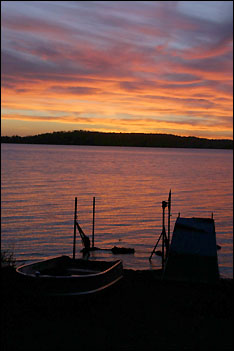KLA unveils lake owner's manual
The Koronis Lake Association (KLA), along with the Rice Lake Association, completed a five-year Rice-Koronis lakeshed management plan last summer with the goal of improving water quality by 2008.
 That means the elimination of algae blooms in these local lakes in four years. In 2008, said KLA vice president Dale Lorenz, the goal is to go the whole summer without any slimy green water or scum on the surface. "We may not attain it, but we certainly want to improve towards this goal," he said.
That means the elimination of algae blooms in these local lakes in four years. In 2008, said KLA vice president Dale Lorenz, the goal is to go the whole summer without any slimy green water or scum on the surface. "We may not attain it, but we certainly want to improve towards this goal," he said.
The owner's manual is a way to educate lake owners and other lake users about the best environmental practices for the lake. People have done "awful things out of ignorance," said Lorenz, expecially new lake owners.
The owner's manual attempts to educate people about lake-friendly practices. Lake pollution is caused by human activity, but the lakes can heal themselves if people protect it. "The solution to pollution rests with all of us individually," said Lorenz, who researched and wrote the owner's manual.
In the last 150 years, Lorenz writes in the manual, human activity has changed the pristine condition of Lake Koronis. "The answer (to pollution) is we created the problem. The solution is we solve the problem," he told 50 KLA members at the annual meeting on Saturday morning at the Paynesville Area Center.
The 24-page manual contains six sections, including Caring for Lake Koronis, Enjoying the Lake, and Improving Your Property.
Lake Koronis, a water-filled canyon formed by glaciers in the last ice age, once had pristine water, but humans have exceeded the lake's ecological carrying capacity, wrote Lorenz. "Pollution can be defined as anything that doesn't belong in the water: fertilizer, animal and human waste, soil, chemicals, garbage. Our very presence means that we contribute to this pollution, but we can do many things to minimize our impact," Lorenz wrote in the manual.
"Our lake has a tremendous ability to clean itself, but we must not continue to overwhelm it," he added. In the section "Caring for Lake Koronis," the manual urges people not to feed the lake nutrients, to keep toxic chemicals out of the lake, to keep septic systems operating properly, to keep ashes out of the lake, and to dispose of trash properly.
Tips include:
*Fertilizing only what is absolutely needed and with a phosphorus-free fertilizer;
*Keeping grass clippings out of the lake;
*Avoiding gas and oil spills in the lake (by filling all portable tanks on shore, not on the boat);
*Using the oil recycling depot in Paynesville Township or the hazardous waste collection each spring to dispose of used oil and other chemicals.
*Making sure your septic system is working properly and caring for the system to insure its continued proper functioning.
*Removing ashes from campfires (not allowing them to wash into the lake).
*Disposing garbage properly.
*Creating a buffer between your yard and the lake.
*Preventing soil erosion.
*Picking up pet waste and putting it in the garbage, not allowing it to wash into surface water.
*Cleaning boats on shore, not in the water.
*Avoiding cleaning products like bleach and ammonia by the lake (on boats or docks, etc.) and using alternatives like lemon juice and vinegar. *Checking boats and trailers for exotic species every time to avoid their spread.
*Disposing of unwanted minnows and worms on shore and not in the lake.
*Refraining from using herbicides or mechanical harvesters to remove weeds, which disturbs the natural balance between algae and weeds.
*Composting weeds; not disposing of them in the water, which returns nutrients to the lake.
Other sections of the manual include boating rules and courtesy, reading buoys, how to get proper permits for lakeshore or building projects, and general information about Lake Koronis.
Koronis has approximately 500 residences around the 3,100-acre lake. KLA, to whom roughly half of these property owners belong as members, intends to deliver these handbooks to all the property owners on the lake, dividing the lake into sections and having section captains deliver the manuals.
These manuals will also be distributed to new property owners on Lake Koronis to educate new lake residents on lake-friendly environmental practices.
(Editor's Note: Press publisher Peter Jacobson is the president of the Koronis Lake Association.)
Contact the author at editor@paynesvillepress.com • Return to News Menu
Home | Marketplace | Community